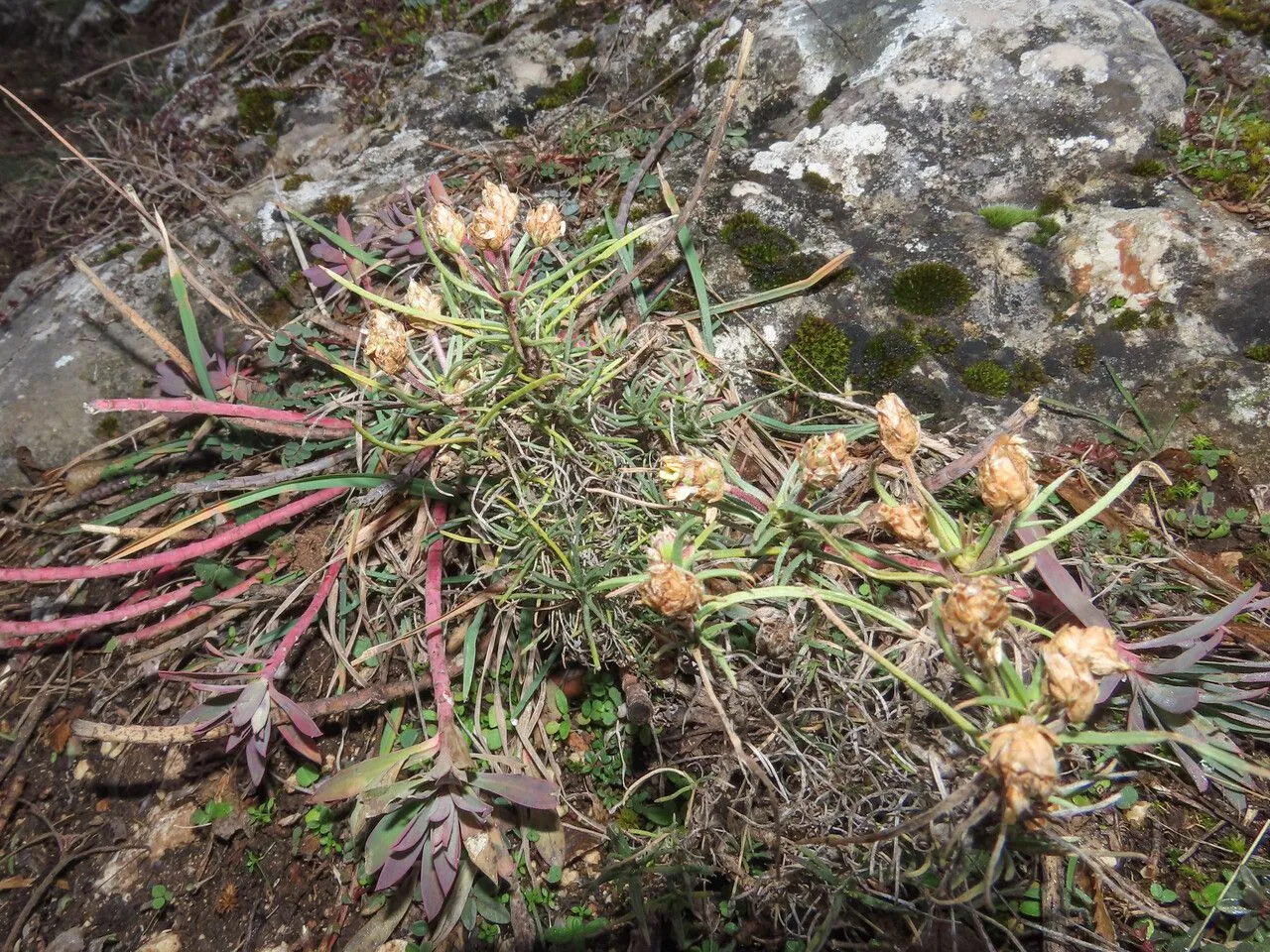
Author: Crantz
Bibliography: Inst. rei herb. 2:331. 1766
Year: 1766
Status: accepted
Rank: species
Genus: Plantago
Vegetable: False
Observations: S. Europe
The evergreen plantain is a resilient and enduring species that belongs to the Plantaginaceae family. Classified under the scientific name Plantago sempervirens, this perennial plant is native to Southern Europe and thrives in its temperate climates.
Renowned for its hardiness and evergreen nature, the evergreen plantain maintains its foliage throughout the year, providing a reliable splash of green even in the colder months. This characteristic is embedded in its name “sempervirens,” which translates to “always green” in Latin.
Plantago sempervirens was first documented by the botanist Heinrich Johann Nepomuk von Crantz in 1766, where it was included in his seminal work, “Institutiones rei herbariae.” Crantz’s meticulous description of the evergreen plantain in “Inst. rei herb. 2:331” laid the foundation for its classification and study within the botanical community.
The evergreen plantain is typically found in open, sunny locations, often along roadsides and in grassy meadows. It is characterized by its lance-shaped leaves that form a basal rosette. The leaves are smooth, glossy, and dark green, contributing to the plant’s year-round verdure. During the blooming season, it produces small, inconspicuous flowers on slender spikes, which are primarily wind-pollinated.
The eco-region where Plantago sempervirens naturally occurs provides suitable conditions for its growth, aiding in its ability to withstand varied environmental conditions. Its adaptability to different soil types and its tolerance to drought make it a species of interest not only ecologically but also horticulturally.
In addition to its ecological and aesthetic values, the evergreen plantain holds cultural significance in the southern regions of Europe where its presence is a fixture of the landscape. Traditional uses may include medicinal applications, leveraging various parts of the plant for herbal remedies known historically in these regions.
With its persistent green foliage and sustainable growth habits, Plantago sempervirens stands as a testament to the enduring beauty and resilience of the plant kingdom. Its role within its native habitat underscores the importance of preserving such species to maintain biodiversity and ecological balance.
Deu: strauch-wegerich, halbstrauchiger flohsame
Swe: buskkämpar
Eng: evergreen plantain, shrubby plantain
En: Evergreen plantain, Shrubby plantain
Ca: Plantatge de ca
Fi: Talviratamo
Fr: Plantain sempervirent, Plantain toujours vert, Herbe aux puces, Oeil-de-chien, Œil de chien
De: Halbstrauchiger Flohsame, Strauch-Wegerich, Flöhkraut, Halbstrauchiger Wegerich, Hundsgesicht, Strauchwegerich
It: Piantaggine legnosa
Es: Hierba pedreguera, Zaragatona mayor
Sv: Buskkämpar
Taken Apr 29, 2021 by Llandrich anna (cc-by-sa)
Taken Apr 15, 2017 by Yoan MARTIN (cc-by-sa)
Taken Apr 15, 2017 by Yoan MARTIN (cc-by-sa)
Taken Dec 29, 2021 by Emanuele Santarelli (cc-by-sa)
Taken Dec 29, 2021 by Emanuele Santarelli (cc-by-sa)
Taken Apr 15, 2017 by Yoan MARTIN (cc-by-sa)
Taken Apr 15, 2017 by Yoan MARTIN (cc-by-sa)
Taken Apr 15, 2017 by Yoan MARTIN (cc-by-sa)
Taken Apr 15, 2017 by Yoan MARTIN (cc-by-sa)
Taken Dec 29, 2021 by Emanuele Santarelli (cc-by-sa)
Taken Sep 2, 2014 by Tela Botanica − Alain BIGOU (cc-by-sa)
Taken Sep 2, 2014 by Tela Botanica − Alain BIGOU (cc-by-sa)
Taken Jun 19, 2021 by sebastien Ledentu Determ (cc-by-sa)
Taken Apr 30, 2021 by Albert Mallol Camprubí (cc-by-sa)
Taken Jun 2, 2022 by Laurence Gaume (cc-by-sa)
Taken Apr 4, 2022 by Denis Bastianelli (cc-by-sa)
Taken Mar 15, 2022 by Stéphane Mars (cc-by-sa)
Taken Mar 18, 2017 by Llandrich anna (cc-by-sa)
Taken May 1, 2019 by Tela Botanica − Sylvain Piry (cc-by-sa)
Taken May 7, 2016 by Tela Botanica − John DE VOS (cc-by-sa)
Taken Dec 1, 2022 by 🌿 Clement Devaux – LEEPS 🌿 (cc-by-sa)
Taken Nov 24, 2022 by Llandrich anna (cc-by-sa)
Taken Dec 1, 2022 by 🌿 Clement Devaux – LEEPS 🌿 (cc-by-sa)
Taken Dec 1, 2022 by 🌿 Clement Devaux – LEEPS 🌿 (cc-by-sa)
Taken Nov 22, 2022 by Kilhiann Bagur (cc-by-sa)
Taken Jan 1, 1970 by Photoflora – L’Abbé COSTE (©)
Taken Jun 29, 2011 by Tela Botanica − Bertrand BUI (cc-by-sa)
Taken May 8, 2013 by Tela Botanica − Dominique REMAUD (cc-by-sa)
Taken Dec 1, 2022 by 🌿 Clement Devaux – LEEPS 🌿 (cc-by-sa)
Taken May 7, 2016 by Tela Botanica − John DE VOS (cc-by-sa)
Bloom months: [‘may’, ‘jun’, ‘jul’, ‘aug’]
Family: Myrtaceae Author: (F.Muell.) K.D.Hill & L.A.S.Johnson Bibliography: Telopea 6: 402 (1995) Year: 1995 Status:…
Family: Rubiaceae Author: Pierre ex A.Froehner Bibliography: Notizbl. Bot. Gart. Berlin-Dahlem 1: 237 (1897) Year:…
Family: Sapindaceae Author: Koidz. Bibliography: J. Coll. Sci. Imp. Univ. Tokyo 32(1): 38 (1911) Year:…
Family: Asteraceae Author: A.Gray Bibliography: Pacif. Railr. Rep.: 107 (1857) Year: 1857 Status: accepted Rank:…
Family: Fabaceae Author: Medik. Bibliography: Vorles. Churpfälz. Phys.-Ökon. Ges. 2: 398 (1787) Year: 1787 Status:…
Family: Aspleniaceae Author: (Cav.) Alston Bibliography: Bull. Misc. Inform. Kew 1932: 309 (1932) Year: 1932…